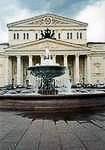 The foundation of Bolshoi Theater traditionally dates back to the 6th of January of 1825, when a fine classical building with 8-columned portico crowned by the carriage of Apollon appeared in the Theater's Square. The new theatre is considered to be the second largest of Europe after the famous "La Scala" Theater of Milan. However, the theatrical company had already existed for a half of century. And in honor of the inauguration of the theatre this company performed "The triumph of Muses".
The foundation of Bolshoi Theater traditionally dates back to the 6th of January of 1825, when a fine classical building with 8-columned portico crowned by the carriage of Apollon appeared in the Theater's Square. The new theatre is considered to be the second largest of Europe after the famous "La Scala" Theater of Milan. However, the theatrical company had already existed for a half of century. And in honor of the inauguration of the theatre this company performed "The triumph of Muses".
The company was created by a province public prosecutor Petr Vasilievich Ursov in 1772. Later the company was headed by his partner energetic and enterprising Englishman Michael Medox. Thanks to him on the abandoned ground regularly flooded by Neglinka river the new theatre was built. The second half of the 19th century is a period of national originality of Russian Art and Moscow Theater. The creative activity of such composers and directors as Alexis Verstovsky and Alexander Varlamov contributed to the unusual raising of the theatre. They formed Russian Opera repertoire. The most favorite operas of that time were works by Michael Glinka "The Life for the Czar" and "Ruslan and Lioudmila", which could survive and win the italianomania tendency of that time. And till now traditionally every Theater season begins one of the operas of Glinka.
As for the Ballet the performances based on Russian themes were replaced by Western romantic themes in the middle of the 19th century. "Sylphide", "Gizel", "Esmeralda" were performed in Russia very soon after premieres in Europe. In 1853 the building of the Theater was badly damaged by fire. In May of 1855 the construction works based on the sketch of the architect Albert Cavos began. And already in August of 1856 the inauguration of the new theatre was celebrated by the premiere of the opera Bellini. The Italian performance was symbolic, because the real holder of the Bolshoi Theater became Merelli who brought from Italy a very gifted theatrical company. Russian public admired the Italian troupe very much.
The season usually began in September and lasted till the end of May (as now). However, the performances used to be presented twice a week. And only in the middle of the winter when all the nobility came back to Moscow, the operas and ballets were put on the stage more often. That was also a time of masked balls. Today the ballet and opera fans attend the theatre every night. The radical turn of the tastes of public happened in 1870, when gradually appeared the Russian operas "Demon" by Rubenstein (1881), "Eugeny Onegin" by Chaikovsky (1881), "Boris Godunov" by Mysorgsky (1888), "The Prince Igor" by Borodin (1893) and other. In 1899 Fedor Shaliapin, great Russian singer, became a member of the company. Great Russian Opera Theaters are not only musical cultural centers, but also academies of professional acting technique. Trainees' group of Bolshoi Theater is still existing to crown the joy of young singers, conductors, directors, leaders of a chorus.
It is situated on two territories, separated from each other by several city districts. It gives the opportunity to represent the whole history of Russian art from the ancient period to our contemporaries. Besides, the structure of the Tretyakov Gallery includes memorial museums: A. Vasnetsov's flat, V. Vasnetsov's



